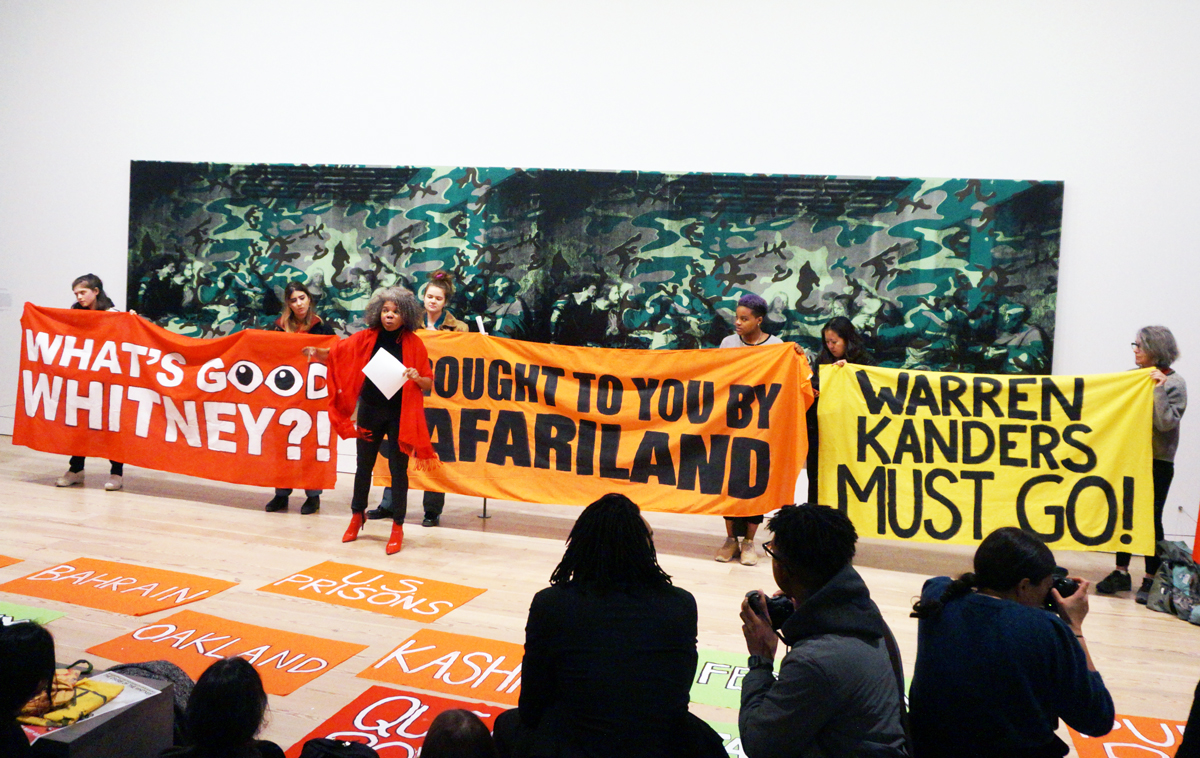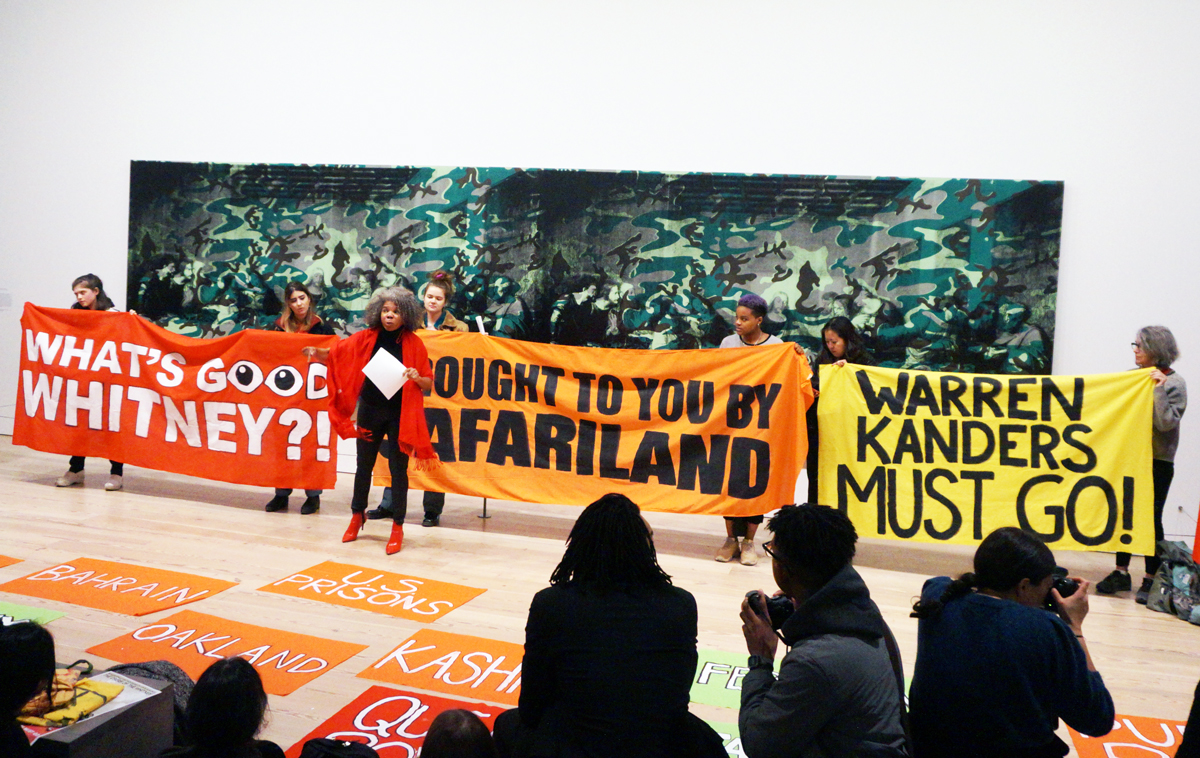[ad_1]

A protest held by Decolonize This Place held at the Whitney Museum on March 22, 2019.
KATHERINE MCMAHON/ARTNEWS
Warren B. Kanders, the vice chair of the Whitney Museum in New York, said that he will resign from his position after more than half a year of protests against his ownership of Safariland, a company that produces tear-gas canisters and other supplies used by the military and law enforcement. The news was first reported by the New York Times.
In a letter to the museum’s board, Kanders wrote, “The targeted campaign of attacks against me and my company that has been waged these past several months has threatened to undermine the important work of the Whitney. I joined this board to help the museum prosper. I do not wish to play a role, however inadvertent, in its demise.”
Kanders’s departure comes just days after eight participants in the Whitney Biennial requested that their work be pulled from the show because of Kanders’s continued presence on the board. According to two of the artists reached by ARTnews, their pieces were slated to be removed by August 2, but no works have yet been taken out.
Adam Weinberg, the Whitney’s director, said in a statement, “Warren and Allison Kanders have been unwavering in their commitment to this institution, including a generous lead gift towards the Museum’s building project. The Whitney’s groundbreaking Warhol exhibition and the past exhibitions of the works of Laura Owens, Jeff Koons and Wade Guyton, among others, were in part made possible thanks to their support. As Director, I am very grateful.”
Kanders had been on the museum’s board since 2006. Richard DeMartini, the president of the Whitney’s board, said in a statement, “Our deepest thanks to both of them for their devotion and service to the Whitney.”
A museum spokesperson said that a stairway named for Kanders and his wife will not be renamed.
The resignation comes amid months of protests, open letters, essays, and debate. The activist group Decolonize This Place has led the charge on the matter, having held one action in December and nine weekly protest throughout the spring, in the run-up to the opening of the biennial. The last of those protests culminated in a march to Kanders’s home in Manhattan’s West Village.
In a statement, Decolonize This Place said, “We welcome this step by the museum leadership as an act of good faith, responsive to the staff, community groups, activists, organizers, artists, and thinkers who have demanded the removal of Kanders.” The internal deliberations that led up to Kanders’s decision to resign are not yet known.
[See a complete timeline of the Kanders controversy.]
The controversy surrounding Kanders first erupted in November, when Hyperallergic reported that Safariland had produced tear-gas canisters that were being thrown at asylum seekers along the U.S.-Mexico border. An open letter to Whitney leadership signed by nearly 100 museum staff members followed. In their letter, the staff asked that the museum’s leaders consider asking for Kanders’s resignation.
In response to that letter, Adam Weinberg, the museum’s director, issued a statement in which he acknowledged the difficulty of the situation and said employees should have discussions about it. “We respect the right to dissent as long as we can safeguard the art in our care and the people in our midst,” he wrote.
Kanders also responded with a statement in which he said he was “not the problem.” “While the staff at the Whitney felt the need to speak out, which I fully support, it is unfortunate that they did not first reach out to me,” he said.
Since the first Hyperallergic report, other outlets and activists have investigated the scale of Safariland’s operations. Research by artists and reports by journalists have revealed that Safariland canisters have also been used against protestors in Ferguson, Missouri, Turkey’s Gezi Park, the Gaza Strip, Standing Rock in North Dakota, and, most recently, San Juan, Puerto Rico.
In April, shortly before the Whitney Biennial opened, nearly half of the exhibition’s participants added their names to an open letter published by the Brooklyn-based publisher Verso that demanded Kanders’s resignation. At that stage, no artists had yet dropped out, but one had declined to participate in the show altogether: Michael Rakowitz, who told the New York Times that he would refuse to participate in protest.
A few participants dealt with the Kanders controversy, though none more head-on than the London-based group Forensic Architecture, which invited Laura Poitras’s Praxis Films to help create Triple-Chaser (2019), a film focused on Kanders’s philanthropy and the use of ammunition produced by Sierra Bullets, another company in which Kanders has a stake, in Gaza by Israeli soldiers. Eddie Arroyo exhibited a painting of a Decolonize This Place protest and a tear-gas canister appeared in an expansive Pat Phillips painting.
Pointing to the Whitney staff letter’s recommendation that the museum establish a “clear policy” about receiving funding from trustees, Poitras told ARTnews that the institution must launch a new system for how it accepts donations. “We appreciate that [the museum’s board] has taken action, but those guidelines will prevent this from happening again,” she said. To establish such a system would set “some sort of moral paradigm.”
Forensic Architecture and Arroyo were among the artists who requested the removal of their work last week, following the publication in Artforum of an essay titled “The Tear Gas Biennial,” in which writers Hannah Black, Ciarán Finlayson, and Tobi Haslett encouraged biennial participants to boycott the show. “We have heard that it would be impossible to remove Kanders; everything is impossible before it happens,” they write.
In response to that essay, Korakrit Arunanondchai, Meriem Bennani, Nicole Eisenman, and Nicholas Galanin published a letter in Artforum in which they asked the museum to pull their work from the show. Forensic Architecture, Arroyo, Christine Sun Kim, and Agustina Woodgate followed suit a day later. Weinberg responded by saying in a statement, “While the Whitney is saddened by this decision, we will of course comply with the artists’ request.” On Instagram, Eisenman said her work would remain in the exhibition.
The debate surrounding Kanders comes as many institutions have come under scrutiny from activists for the sources of their funding and their leadership. Earlier this year, Yana Peel, the CEO of the Serpentine Galleries in London, resigned after the Guardian reported that she has connections to an Israeli tech firm that had been using its products against Saudi Arabian dissidents. Many museums have also said they will no longer accept funding from the Sackler family amid reports about some family members’ alleged role in misleading the public about the addictiveness of OxyContin, an opiate produced by Purdue Pharma, a company owned by some members.
Amin Husain, a member of Decolonize This Place, said that the Kanders resignation marks another step toward institutional change. “There not be a gap between the shows that go up and that money that’s funding them, and what that does in terms of artwashing,” he told ARTnews. “Whether it’s the Sacklers, whether it’s BP oil, whether it’s the Boycott, Divestment, Sanctions movement in the art world—all of these things are pointing to a politics of accountability. It’s the recognition that these museums are not neutral. They’re just not neutral.”
[ad_2]
Source link

